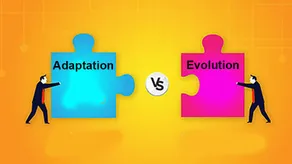
Some would argue that Evolution is a result of accumulations of adaptations!
This claim is a result of outdated science!
When Wallace and Darwin made their observations, they only understood the external features of the creatures that they were investigating (phenotypes). They looked at external body shapes and on skeletons in fossils, but they had no idea about genetics, which is the source of those manifestations, simply because genetics was not discovered yet!
The matter is that we have three facts that are observable and reproducible, which are inheritance, migration, and adaptation, that can work together very well to explain the geodiversity of the living creatures around us.
When an animal’s environment gets tough the animal migrates gradually away from the tough environment to the more amicable environment.
1. Animals migrate to environments that are more suitable for them when their own environments change.
2. Epigenetics, mechanisms which control the expression of certain genetic features according to environmental conditions, will cause a shift towards the expression of features that are more suitable to the environment.
3. Natural selection, (including an election of the fittest male by females (or vice versa)), would push give advantage to the traits that are more fit to survive in the environment and reproduce more, and hence, new offspring, through inheritance, will have a bias towards features that make them more fit to the specific environment.
All the above mechanisms operate within the existing genetic and epigenetic possibilities of the creature. Making the same animal look different in different geographies, weathers, altitudes, and ecologies.
Now, what happens in the vast majority of Evolutionary propaganda that is fed into pop culture is that they would extrapolate the effect of Adaptation and claim that those changes will just continue indefinitely to the extent that an animal will morph into a completely different animal, forming new species that have radically different features versus the first one, and will stop mating with it!
But, this is false for many reasons key of which are:
1. Genetics:
AIntheend, all adaptation mechanisms will still select from an existing set of possibilities within the genotypes of the organism, so, no matter how many times the length of the bones of a limb, or the shape of the fingers are selected from, the hand will never become a wing. The wing has a different density of bones, and has feathers, and is specifically engineered for flying. The genetic code generating the design of the wings is simply not existent at all in a creature that has hands so that the wing will be developed by any selection of options from such hand-genetic-material.
2. Observation:
Let us say it this way: No matter how much we would wish for having a Pegasus, no matter how many times and whatever environmental stress we put on a horse for whatever time, there is no way that we will be able to generate a Pegasus.
Humans have been breeding dogs for thousands of years, maybe billions of dogs have been subjected to change in the environment and severe stresses! It caused many variations in the shape and features of the dogs through planned mating and continuous artificial selection of features, but dogs remained dogs.
And house cats remained house cats. After thousands of years, they still can’t still talk to humans and would still meadow till today.
And horses remained horses.
…
Notes:
Small adaptations in terms of expressing existing genes are acceptable, as the genetic code already exists.
(Evolution by mutation) in terms of re-editing the genetic code, or adding new genes is not acceptable, as errors and their accumulation will not create a better version of the creature, but rather a diseased, deformed, or disabled version, that will soon fail to survive. The unlikely and very few events of beneficial mutations are by no means capable of writing a new program, and for sure will not have mutual constructive mutations to come later in the course of time to the extent that a consistent direction of chance is maintained; randomness does not have direction. To expect that natural selection will do the trick through ruling our unbeneficial mutations and keeping only the ones that are mutually constructive suffers from the same fault of assuming order will come from a random and blind process. It is not reasonable to expect that adding two random and blind processes together will find a very rare correct solution in an exponentially increasing search space with the increase in the number of mutually constructive mutations needed.
…
It should be noted that similarity in DNA between any two creatures with similarity in the general appearance will be quite significant. DNA is responsible for building proteins. If two creatures are using similar proteins, and have similar body shapes, DNA will have plent of similarity.
Similarity is not evidence for evolution (Homoplasy does not imply Homology unless common ancestry is first established).
Similarity and diversity together is the observation that makes us look for an explanation.
Evolution is a proposal for an explanation (a theory is an explanation).
To prove a theory you cannot refer back to the basic observation.
You need to prove the mechanism that you claim is responsible for evolution.
You have to either SHOW that it works and delivers the required effect (for example transform an ape into a human),
Or the Theory makes predictions, and then show that those predictions, which are based on the theory do actually occur (and this does not include Tiktaalik which does not qualify as a prediction).
Neither of the above is available for evolution.
It is hence a failed hypothesis.